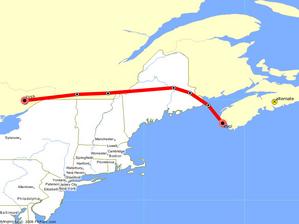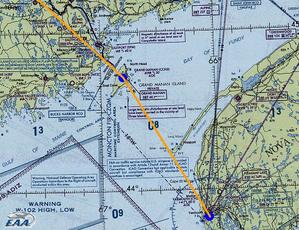I had a very interesting glide performance test flight late yesterday afternoon.
 Eventually, I plan to use the RV-8 for quite a few trips back to Yarmouth, NS, to visit my parents and sister. Yarmouth is on the western tip of Nova Scotia, and you have a choice of flying over the Bay of Fundy, or going quite a bit further east to stay over land. The "over land" route adds an hour to the trip, so I am very interested in the Bay of Fundy route.
Eventually, I plan to use the RV-8 for quite a few trips back to Yarmouth, NS, to visit my parents and sister. Yarmouth is on the western tip of Nova Scotia, and you have a choice of flying over the Bay of Fundy, or going quite a bit further east to stay over land. The "over land" route adds an hour to the trip, so I am very interested in the Bay of Fundy route.
 The Bay of Fundy is 24 nm wide if you cross from Grand Manan Island to Digby Neck. I want to know how high I need to be to ensure that I could get to land if the engine failed in the middle of the crossing.
The Bay of Fundy is 24 nm wide if you cross from Grand Manan Island to Digby Neck. I want to know how high I need to be to ensure that I could get to land if the engine failed in the middle of the crossing.
I had assumed that it would be relatively easy to get the engine to stop turning after it was shut down, by reducing the airspeed. I planned to conduct a series of glide tests with the engine stopped at various airspeeds. I would then repeat with prop windmilling near best glide speed, and do another one with the engine running at idle, to see the differences.
After getting airborne yesterday, I did a couple of practice forced landings with the engine at idle, just in case. Then I climbed to 8000 ft, slowly pulled the power to idle, then pulled the mixture to OFF. The prop continued to windmill. I trialed the restart procedure (throttle just above idle, and smoothly push the mixture to RICH). The engine started immediately, as evidenced by the EGTs increasing. I shut it down again, and slowed to the stall, intending to do another restart test using the starter. The prop continued to windmill, even at the stall. I quickly amended the plan of the day to do all glide tests with prop windmilling.
I did two runs at each speed, one at 030 heading, and one at 210 heading (the forcast wind was 300, i.e. at 90 degrees to these headings). I flew test points at 80, 90, 100, 110 and 120 kt), timing the decent from 8000 ft to 7000 ft.
I was still wondering whether it was possible to get the prop to stop, so I climbed to 10,000 ft, pulled the mixture OFF, pushed the throttle to MAX (to increase the torque required to spin the engine), put the flaps fully DOWN, and slowed to just above the stall. The rpm very slowly decreased, and the engine finally stopped about 2 minutes after shutdown. I increased the airspeed, retracted the flaps, and did a glide test at 80 kt from 7300 ft to 6300 ft, then used the starter to restart the engine. I climbed back up and repeated on the reciprocal heading. After this one I very slowly increased the speed, and found that the engine would start spinning again at about 95 kt.
I cleverly left my log card with all the times, fuel quantities, etc in the aircraft, but I do have all the data I recorded on the laptop. But analyzing that data will be more work than expected, as I neglected to put the EFIS altimeter to 29.92.
The original Dynon EFIS software sent barometric altitude in every record, so if you forgot to set 29.92 you simply had a correction to make to the altitude on every record. But they eventually changed the software to alternate between pressure altitude and barometric altitude - one record has pressure altitude, and the next one has barometric altitude. They set a bit at the end of the record to indicate which type of altitude is contained in that record. But, I never updated my data recording script to check that bit, so it simply records every altitude, no matter what kind it is. So if I plot the altitude from this flight, I see that it jig zags up and down. I know what the altimeter setting was - now I need to write a script to correct every other record so I have a clear set of data to analyze.
I did a very quick "back of the envelope" calculation, using the raw data that I recall for 80 kt with prop stopped, and 90 kt with prop windmilling. The glide ratio was about 9.4:1 at 80 kt with prop stopped. It would be slightly better at 90 kt, but there would be a significant risk that the prop would start spinning. The glide ratio at 90 kt with prop windmilling, prop control full aft and throttle at idle was about 8.2:1. These intial estimates will be updated once the full data analysis has been completed.
Lessons learned - Don't count on getting the prop to stop if the engine fails. While it may be possible to get it to stop if the airspeed is kept just above the stall with full flap for two minutes, this yields a steeper glide during those two minutes, and thus it is unlikely that this lost altitude will ever be recovered, even with the slight improvement in glide performance that would occur if the prop could be stopped.
If the prop has stopped on an undamaged engine (engine stoppage due to fuel exhaustion, etc), care should be taken to not increase the airspeed above 90 kt, or the prop may start turning again.
I'll need to be at least 9,500 ft to be able to make land from any point in the crossing of the Bay of Fundy. I can go as high as 13,000 ft for 30 minutes without oxygen, so I'll plan to go to at least 11,000 ft to have some margin for winds, etc.
Update - 22 Nov 2009 - The results from the glide testing were reported here.